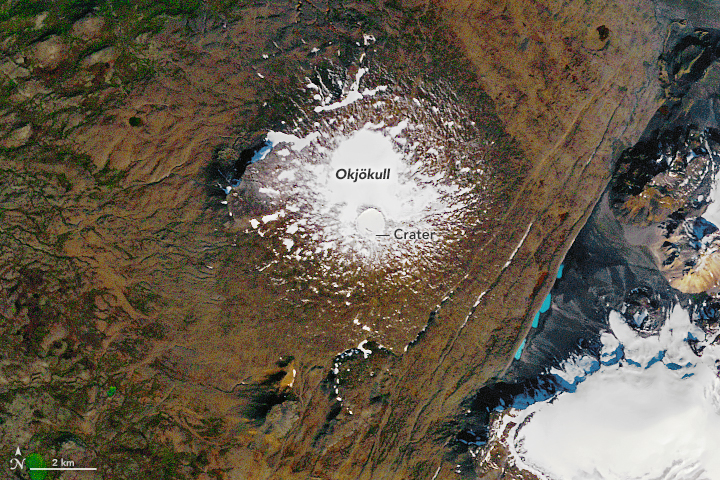

Okjökull Remembered
Downloads
- okjokull_tm5_1986257_lrg.jpg (2182x1974, JPEG)
- okjokull_oli_2019213_lrg.jpg (2182x1974, JPEG)
Metadata
- Sensor(s):
- Landsat 5 - TM
- Landsat 8 - OLI
- Data Date: September 14, 1986 - August 1, 2019
- Visualization Date: August 8, 2019
On August 18, 2019, scientists will be among those who gather for a memorial atop Ok volcano in west-central Iceland. The deceased being remembered is Okjökull—a once-iconic glacier that has melted away throughout the 20th century and was declared dead in 2014.
A geological map from 1901 estimated Okjökull spanned an area of about 38 square kilometers (15 square miles). In 1978, aerial photography showed the glacier was 3 square kilometers. Today, less than 1 square kilometer remains. The satellite images above show the glacier during the latter part of its decline, on September 14, 1986, (top) and August 1, 2019 (bottom). The images were acquired with the Thematic Mapper (TM) on Landsat 5, and the Operational Land Imager (OLI) on Landsat 8, respectively.
The dome-shaped glacier appears in the 1986 image as a solid-white patch, just north of the snow-filled crater. Snow is also visible around the glacier’s edges. In the August 2019 image, only a spattering of thin ice patches remain. Notice the areas of blue meltwater, which are likely associated with the mass of warm air that hit Iceland as it moved from mainland Europe to Greenland in late July.
The glacier’s demise is not just a matter of shrinking area. Glaciers form from snow that becomes compacted into ice over time. The ice then creeps downslope under its own weight, helped along by gravity. Okjökull has thinned so much, however, that it no longer has enough mass to flow. According to some definitions, a stagnant glacier is a dead glacier.
Okjökull, also called Ok (jökull is Icelandic for “glacier”), was part of the Langjökull group—one of Iceland’s eight regional groupings of glaciers. Ice covers about 10 percent of the island, making it an integral part of the landscape. Loss of glacial ice has wide-ranging effects, with the potential to impact water resources, infrastructure, and even the rising of the land as it rebounds under a lighter load of ice.
Scientists have noted that glaciers have disappeared from Iceland before, although perhaps none as ceremoniously as Okjökull. Anthropologists from Rice University produced a film about the glacier’s demise, and a plaque is set to be installed on the site of the former glacier.
- Björnsson, H. (2016) Glaciers of the Central Highlands. The Glaciers of Iceland, 275–336.
- Earth Institute, Columbia University (2019, August 1) Iceland to Commemorate the Demise of Okjökull Glacier. Accessed August 8, 2019.
- Mental Floss (2019, August 1) Iceland to Unveil a Plaque Dedicated to Okjökull, the First Glacier Killed By Climate Change. Accessed August 8, 2019.
- Reuters (2019, August 10) As glaciers melt, 'Land of Fire and Ice' watches its history seep away. Accessed August 8, 2019.
- Rice University News & Media (2019, July 18) Lost glacier to be honored with memorial monument. Accessed August 8, 2019.
- Slate (2019, July 24) How Can You Tell When a Glacier Is Dead? Accessed August 8, 2019.
- U.S. Geological Survey Professional Paper 1746, Geographic Names of Iceland’s Glaciers: Historic and Modern. Accessed August 8, 2019.
NASA Earth Observatory images by Joshua Stevens, using Landsat data from the U.S. Geological Survey. Story by Kathryn Hansen.
This image record originally appeared on the Earth Observatory. Click here to view the full, original record.